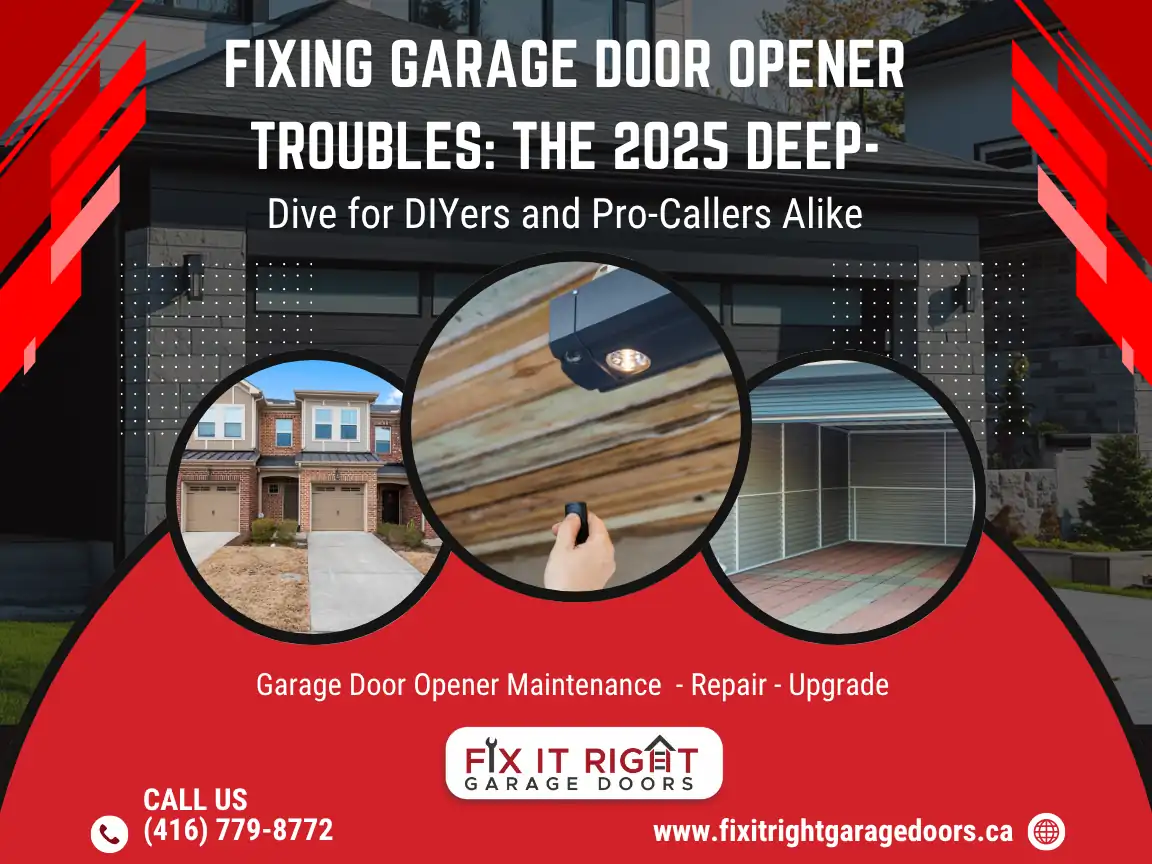Is your garage door making weird sounds, getting stuck halfway, or refusing to budge at all? You’re not alone! Many homeowners rely on garage doors repairs to keep their homes secure, cars accessible, and lives stress-free. In 2025, fluctuating part costs, evolving door technologies, and Ontario’s variable climate all influence how, when, and why you’ll need professional help—or at least a solid maintenance routine. Let’s explore everything you need to know to enjoy a smooth, safe, and resilient garage door. ⚙️
Reliable Garage Doors Repairs in Toronto And The GTA
A functional garage door matters for more than just looks. It shields your belongings from theft, keeps out rain and snow, and makes daily commutes more convenient. When trouble strikes—like a snapped spring or a misaligned track—it can disrupt your entire schedule. That’s where garage doors repairs come in, offering quick fixes that restore safety and peace of mind. Whether you’re dealing with minor glitches or major breakdowns, understanding your door system, the common issues that arise, and the best ways to tackle them sets you up for success.
Below is a brief overview of some typical garage door problems, plus potential solutions and cost ranges. It’ll give you a glimpse of what you might encounter before we dive into the nitty-gritty.
| Common Issue | Possible Cause | Likely Solution |
|---|---|---|
| The door is not opening fully | Faulty springs or opener | Spring replacement/opener tune-up |
| Loud grinding noises | Worn rollers, unlubricated parts | Lubrication/roller swap |
| Door reverses mid-close | Sensor misalignment | Adjust/clean safety sensors |
| Slow or jerky movement | Bent tracks or a weak motor | Track realignment/motor upgrade |
| Gaps at the bottom | Worn weather seal | Replace the seal or threshold |
Whether you require emergency garage door repairs, a quick tune-up, or a brand-new motor, let’s dig deeper into the components, steps, and best practices that keep your garage door running like new. ✨
Why Garage Doors Break Down
Your garage door moves a lot—sometimes multiple times a day, all year round. Over time, every part experiences wear and tear. From harsh winter climates to day-to-day usage, these stresses can lead to broken springs, stripped gears, or misaligned tracks.
- Temperature Fluctuations: Extreme cold can make metals brittle and lubricants thick. Hot summers may lead to warping or drying out of seals.
- Everyday Use: Opening and closing your door is repetitive, and springs or cables rated for a set number of cycles eventually fail.
- Accidental Damage: Bumping the door with your car (it happens!) or debris from storms can dent panels or bend rails.
A homeowner in Ottawa discovered their door would slam shut at the halfway point during winter. The culprit was a weakened torsion spring that finally snapped under the cold. A timely spring replacement prevented further damage to the opener.


Top Warning Signs Your Door Needs Attention
It’s tempting to ignore small quirks until they become big problems. But catching issues early can save time, money, and stress. Look out for:
- Sudden Loud Bang: Often signals a broken spring or cable under tension.
- Uneven Door Movement: If one side rises faster, you might need affordable garage doors repairs—likely track realignment or extension spring fixes.
- Unusual Vibrations: Excessive trembling could mean loose brackets, rollers, or an underpowered motor.
- Inconsistent Opener Response: A door that only opens sometimes might have faulty sensors or a dying motor board.
If any of these raise red flags, don’t wait. A small fix today is often cheaper than an emergency call later. ⚠️
Key Components Every Homeowner Should Know
Understanding how your door works helps you spot trouble early. Basic garage door systems include:
- Springs – Torsion or extension springs offset the door’s weight.
- Cables & Drums – Transfer spring tension to lift the door.
- Tracks & Rollers – Guide the door’s movement along metal rails.
- Opener & Motor – Pulls the door up/down when you press a remote or wall button.
- Sensors & Safety Features – Stop the door from closing on objects, often mandatory for modern doors.
If you’re aiming for a quick garage door fix, it’s vital to know which component might be acting up. For instance, a cable fray can masquerade as a spring issue, and diagnosing the right part ensures you fix the problem effectively rather than guesswork.
DIY vs. Professional Repairs
Should you roll up your sleeves or call in a pro? That depends on the severity of the problem and your comfort with mechanical work. Some tasks are perfectly safe for a handy homeowner, while others can be downright dangerous.
DIY-Friendly
- Replacing or reattaching weatherstripping
- Tightening loose bolts or brackets
- Lubricating rollers and hinges
- Adjusting sensor alignment or cleaning them
Call a Professional
- Springs Replacement: High-tension springs can cause severe injuries if mishandled.
- Motor Malfunction: Complex electronics and logic boards may require specialized knowledge.
- Bent Tracks: Attempting to straighten tracks incorrectly might make it worse.
- Full Door Replacement: Removing panels or entire door sets is heavy, tricky, and best left to experts.
One homeowner in Mississauga tried to replace a broken torsion spring themselves to save a few bucks. Unfortunately, the spring recoiled, causing injury and damage to the track. They ended up paying more for garage door repairs than if they’d booked a garage door repair near me in the first place. 😬
Common Garage Doors Repairs Solutions
Here’s a practical list showing typical repairs you might face and what they entail:
- Spring Replacement: If one spring fails, many techs recommend swapping both for balanced tension.
- Cable Repair or Roller Upgrade: Frayed cables risk door slippage, while worn rollers make it noisy.
- Opener Motor Fix: Replacing burned-out logic boards, gears, or belts can breathe life into an older motor.
- Track Alignment: A misaligned track can wear rollers and cause the door to stick or jam.
Friendly Example
A family in Hamilton struggled with their noisy door for months, assuming the opener motor was dying. A pro discovered only the rollers were worn out. Replacing them for about $120 solved the racket quickly—no new motor needed!
Budgeting for Garage Doors Repairs
Wondering how much you’ll pay for those garage doors repairs? Costs vary based on part quality, labor rates, and whether it’s an urgent call. Here’s a quick breakdown for reference:
| Service | Approx. Cost (CAD) | Notes |
|---|---|---|
| Spring Replacement (1 or 2) | $150–$400 | Torsion setups cost more; recommended to replace both |
| Cable & Roller Swap | $80–$200 | Great way to extend your door’s lifespan |
| Opener Motor Tune-Up/Repair | $100–$300 | Logic board fixes or gear swaps can be cheaper than the new opener |
| Track Realignment | $100–$250 | May need extra parts if the track is severely bent |
If you need emergency garage door repairs (especially at night or on weekends), expect an extra surcharge of $50–$150. Sometimes you can bundle minor tasks—like replacing rollers or weather seals—during a spring swap, saving on repeated service calls.
Finding Affordable Garage Doors Repairs
Paying a fortune for a simple fix is the last thing anybody wants. Thankfully, you can keep costs reasonable:
- Get Multiple Quotes: Aim for two or three estimates, especially if the repair is significant (like full spring or cable replacements).
- Ask About Bundling: If you need both rollers and cables changed, see if the tech offers a package deal.
- Inquire About Off-Peak Discounts: Some companies may have slower seasons or days when they can offer reduced rates.
- Look for Local Promotions: Check community bulletins or online coupons. Searching “garage door repair near me” might reveal local deals or small businesses offering competitive rates.
A homeowner in London, Ontario, discovered that by scheduling a non-urgent appointment midweek, they saved $40 on their roller and cable replacement. A little flexibility often pays off. 💰
Fast Fixes vs. Long-Term Solutions
Sometimes you just want a quick garage door fix, like tightening a loose hinge or spraying lubricant on squeaky rollers. However, quick fixes may only hold for so long. If the underlying issue is severe (e.g., a weakening torsion spring), a patch-up might fail sooner than you’d think.
- Temporary Solutions: Great for squeaks, minor alignment issues, or a short-term band-aid until parts arrive.
- Permanent Repairs: Address root causes, like old springs, damaged panels, or burnt motor boards.
One woman in Barrie found that repeatedly lubricating her squeaky rollers only delayed the inevitable: the rollers had cracked bearing rings. Upgrading to sturdier nylon rollers fixed the racket for good. Short-term lubrication helped, but the real solution was new hardware.
Why a Professional Garage Door Repair Company Is Vital
You might feel confident handling basic tasks, but certain garage doors repairs demand expert eyes, specialized tools, and the know-how to avoid injuries. A pro can:
- Diagnose Underlying Issues: Sometimes, a loud opener is a spring problem.
- Properly Balance the Door: Over-tensioned or under-tensioned springs strain the motor, risking breakdowns.
- Ensure Code Compliance: Many areas have safety regulations on door sensors and auto-reverse mechanisms.
For dependable repairs in Ontario, visit fixitrightgaragedoors.ca. Skilled technicians handle everything from broken springs to full door replacements, helping you avoid mishaps and repeated breakdowns.
Maintenance Tips for Fewer Repairs
Love saving money and keeping your garage door in tiptop shape? A little TLC goes a long way. Here’s a short list to consider:
- Lubricate Moving Parts: Rollers, hinges, and springs deserve a light silicone-based oil every three months to combat corrosion.
- Check Sensors: Ensure the little LED lights line up, and wipe them if dusty. Misalignment can halt door closure unexpectedly.
- Tighten Bolts: Garage door vibrations loosen hardware. A quick pass with a wrench can prevent track wobble.
- Test the Auto-Reverse: Place a small block under the door. It should reverse as soon as it touches the block to avoid accidents.
An Oakville homeowner who followed these steps noticed their door rarely needed garage doors repairs over five years, avoiding big repair bills and stressful breakdowns. Simple, proactive steps matter. 🚀
Conclusion
Garage doors repairs don’t have to be a nightmare. By watching for early signs, handling minor maintenance, and calling in professionals when needed, you’ll keep your door running smoothly for years to come. Is that rattling noise worth ignoring, or is it a clue your springs are about to fail? Taking a moment to investigate can save you from costly, last-minute fixes.
Ultimately, the question becomes: How comfortable are you tackling small issues yourself, and when is it wiser to bring in an expert? If you’d rather sidestep the risk of spring-related injuries or complicated opener malfunctions, a qualified garage door specialist is just a call away. For more detailed guidance on common fixes, see Family Handyman’s Garage Door Repair Tips—a trusted resource for homeowners.
Weigh your options carefully, plan your repair strategy, and remember that a little maintenance can avoid emergency problems. Whether you need emergency garage door repairs, a brand-new opener, or just a tune-up, staying proactive ensures a reliably functioning garage that keeps your home secure and your routine uninterrupted. What small step could you take today—tightening a loose bracket or testing the sensors—to prevent bigger headaches tomorrow?










